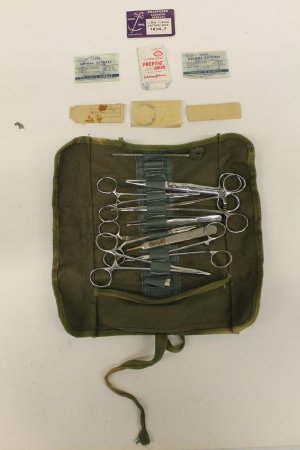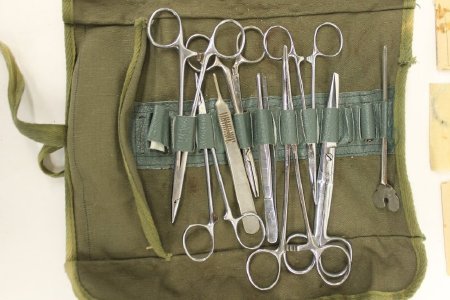Object ID Number:
EH102071
Object Name:
Suture Kit
Manufactured from:
1928
Manufactured to:
1958
Description / History:
Military suture kit in green canvas roll–up case and string ties. Twelve slots made of green leather with nine metal instruments (made in both Germany and the USA). Instruments include tongue–tied director, numerous types of forceps, and scissors. Side pocket contains dermal sutures packets, a preptic swab, stainless 1/2 circle surgical needles, and small blades.
One of the instruments was manufactured by A.S. Aloe & Company, who around the time of the production had a change in leadership leading to their selling of the company in 1958. A newly married man to the owner's daughter, Howard Baer was working for the company only 24 months before his father–in–law suddenly past away. He was left with the company at the start of the depression and fought to keep it going, eventually having sold all other departments besides the surgical department that had originally started the company. It was most likely around this hard time that this particular instrument was made.
The bag itself could have been, and was most likely used, in WWII, the Korean War, and/or the Intervention in Lebanon. If it had been reused, as many surgical kits were, it could have also been used at the start of the Cold War.
One of the instruments was manufactured by A.S. Aloe & Company, who around the time of the production had a change in leadership leading to their selling of the company in 1958. A newly married man to the owner's daughter, Howard Baer was working for the company only 24 months before his father–in–law suddenly past away. He was left with the company at the start of the depression and fought to keep it going, eventually having sold all other departments besides the surgical department that had originally started the company. It was most likely around this hard time that this particular instrument was made.
The bag itself could have been, and was most likely used, in WWII, the Korean War, and/or the Intervention in Lebanon. If it had been reused, as many surgical kits were, it could have also been used at the start of the Cold War.
Dimensions:
W–10 L–10.5 inches

